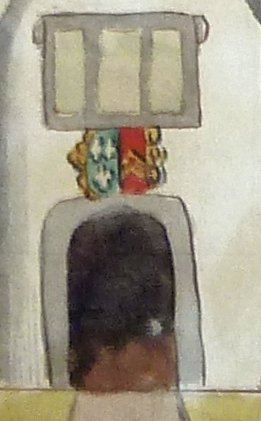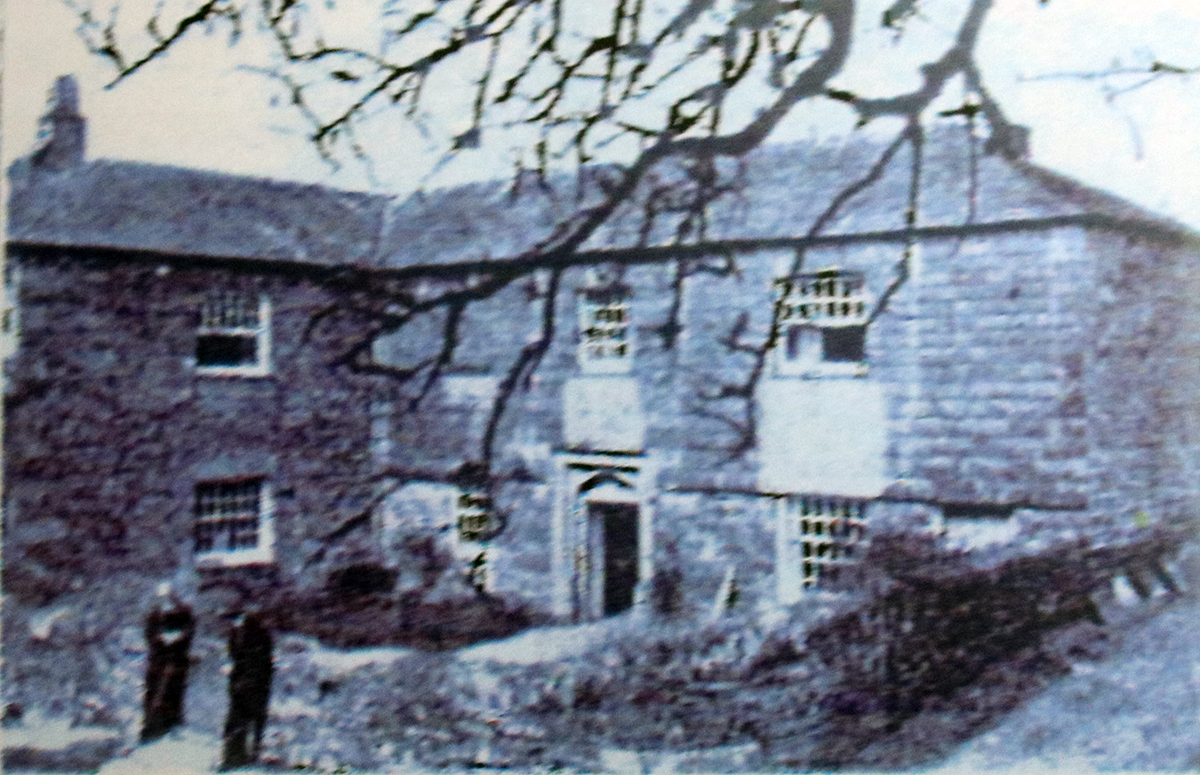


BATTENS
|
|
Battens Farm is one of North Hill Churchtown's oldest buildings; a lintel in the building as it stands today is inscribed with the initials of Thomas Vincent and is dated 1581. A previous building is shown on old maps, perhaps incorrectly, by the word "Mansion". The name dates back to the 14th century. Battens was home to the Vincent and Darley families throughout the 17th and 18th centuries. The farmhouse and buildings are situated immediately to the east of The Racehorse Inn.
1066-1428In the early days of the Norman Conquest, and possibly in earlier times, the land occupied by the tenement of Battens was part of the larger Manor of Landreyne. Landreyne itself was part of the even larger Manor of Rillaton that comprised large tracts of land to the east of the River Lynher. The land to the west of the River Lynher was part of the Manor of Carnedon Prior (Caradon Prior), some of which was controlled by Launceston Priory. Landreyne was under the control of Lord William Wallis until he was dispossessed of his lands and title for a misdemenour. The Book of Spoure records: "Lord Wallis was a Baron, who being attainted, Lost boath his estate, and honour; his ancient Inheritance and Mansion house was Landerine, in this Parish of Northill and also Penhole was annext to itt besides many other Large possessions - they were a Famely of great antiquity and honour.
Who Lord Wallis was, and the actions leading to his fall from grace, has been lost. No reference has been found to definitively establish when Landreyne came into the possession of the powerful Courtenay family of Powderham in Devon but it was likely as a result of the attainder against Lord William Wallis. In his book "Trebartha - The House By The Stream" Bryan Latham suggests this happened in 1349. Over time the Manor of Landreyne was broken up and this probably started with the Courtenay ownership that lasted until 1545. Note: The modern accepted spelling of Landreyne has had many phonetic variants over time including: Landerine, Landrends, Landyar, Landrene and others. Similarly Battens has other variations such as Baten, Battyn and Batyns. |
Battens in The Cartulary of Launceston Priory |
|||||||||||||||||||||||
A typical page from The Cartulary of Launceston Priory. |
The earliest references to Battens may be those that appear in "The Cartulary of Launceston Priory" (Lambeth Palace MS 719). In the mid 1400s the scribes of Launceston Priory were set the task of copying all the ancient and contemporary charts, deeds and associated documents that demonstrated the Priory's ownership of land and property. Some documents dated back to shortly after the Norman Conquest. The collection is known as a 'cartulary'. The modern transcripts were published by The Devon & Cornwall Record Society, the latest reprint being in 1987. The images below are the six numbered transcripts from the cartulary that mention Battens and date from 1378 to 1428. Click on the images to read the transcripts, shown in chronological order. The following text makes reference to these transcripts.
|
||||||||||||||||||||||
 Taken from transcript #149 - the passing of the ownership of Battens from Dowbulday to Hogg |
|||||||||||||||||||||||
|
Transcript #149 is a memorandum describing how the tenement passed from Henry Dowbulday to Philip Hogg. It also indicates the source of the name Battens, from Batyn, when John Batyn married Christiana Dowbulday, probably about 1360. Vivian's Visitations for Devon shows a John Batyn, son of William Batyn of Exeter, settling in the Dunsland area near Holsworthy and marrying into the noble Arscott family. The origins of the Batyn family may, therefore, be found in Exeter. Richard Loryng died without issue and the property passed to Philip Hogg through his great grandfather's sister, Hawise. Transcript #147 dates from 1378 and is the earliest use of 'Batynscrofte' as a place name. The tenement is described here as a 'croft'. The land is located as being between "Landrends" and Launceston Priory land, exactly where it is recorded as Battens tenement in the 1840 tithe apportionment return. Confusingly it records Margery Batyn's father as William Batyn when he is shown as John Batyn on transcript #149. Transcripts #123 and #125 date from 1383 and show Magota, probably Margery, Batyn paying her rent to Sir Robert Tresulyen along with John Landyar (witness in #147) and William Scherp of Landrends. Margery, John and William were renting in either Landreyne or Trecarell, shown here as Trecaru. Transcript #148 dates from 1406 and refers to John Lorynge and Cristine Batyn and that part of Cristine's dowry consisted of "Battynnyscroft". Transcript #146 is from a deed signed at Landrends in 1428 and cites Walter Sherp (possibly son of William in #123 and #125), John Lorying holding "Batyn ys Crofte" in Landrends. One of the witnesses was Nicholas Trebartha whose great grandfather, John, had married Christian, the daughter of the attainted Lord William Wallis of Landreyne. No evidence has yet been found to tell us the history of Battens between 1428 and around 1580.
|
 |
 |
 |
The arms of the Battyn family of Exeter |
Battens from the Book of Spoure |
The arms above the door in the image in The book of Spoure (Vincent impaled by Spoure) |
c1580-1710Battens was home to the Vincent family in the late 1500s and from then until 1710. How much earlier the Vincent family lived at Battens is not known. In the Book of Spoure (1694), the author Edmund Spoure, makes no mention of an earlier family but provides an image of the house (shown above). Around 1580 Thomas Vincent married Jane Lampen of Patrieda in Linkinhorne. She was the daughter of John Lampen, the wealthiest and most influential squire in Linkinhorne at the time. For her to marry, her father would have insisted on her married home being of a standard that was commensurate with the Lampen family status and it can be deduced, therefore, that Thomas Vincent had a family home worthy of his new wife. From this we can assume that the Vincents were of a significant status. Whether Thomas' home was already at Battens in North Hill or he purchased the site and built his house there cannot be certain but the lintel at Battens is dated 1581 and engraved with Thomas' intials which gives us the earliest confirmable date for the Vincents in North Hill. The house built by Thomas has undergone some changes but there are clues to the original structure as recorded on "British Listed Buildings". Battens is now a Grade II Listed Building and is described on 22 November 1960 as follows: "House and adjoining outbuilding. 1581 for C.[sic] T. Vyncent (datestone), altered in circa late C18. Stone rubble, partly slate-hung above ground floor on front. Slate roof with hipped ends. Stone rubble side lateral, rear lateral and end stacks with brick shafts. "Plan: The house is of overall 'L' shaped plan and the original arrangement is uncertain. The main range is of 3 room and cross passage plan; entrance to right of centre with stair to rear of passage and right hand room heated by a lateral stack. There is a corridor across the front left providing access to the central unheated dairy and the kitchen to left which is heated by an end stack. The truncated projecting rear lateral stack may originally have heated this room. Returning to front left a large room heated by a side lateral stack. This wing was extended by the addition of a circa early C19 outbuilding. There are at least 2 straight joints on the rear elevation of the main range and the height of the ceilings and position of the partitions within suggest that the plan has been altered considerably since 1581.  Edwardian image of Battens"Exterior: Two storeys. Asymmetrical 1:3 window front. Entrance to left of centre with granite 4-centred roll moulded arch with carved balls in spandrels and ball and stepped stops. 'ANOD. 1581.C.T. VYNCENT' carved on lintel. C20 door flanked to left with C19 C20 pane sash and to right by C19 24-pane sash and door opening. First floor with two replacement 20-pane sashes and C19 24-pane sash to right. The wing to front left has C19 20-pane sashes on ground and first floor. Lower 2-storey barn attached on front right with C19 plank door near centre, window opening to left and C20 garage doors to right. Three ventilation slit openings on first floor. "Interior: Circa early C19 stair to rear of passage. C18 and C19 doors. The ceiling beams have been largely covered over but appear to be of circa late C18 with bowtell moulding. The fireplaces have C20 grates."
|
1783-1911In March 1783 Battens was sold by William Darley to John Tyeth, a wine merchant in Launceston. From documents in Kresen Kernow and from newspaper advertisements it seems that John Tyeth speculated in property but as he advanced in years he reduced his property portfolio. Battens was sold in 1803 to Francis Rodd (1732-1812) of Trebartha Hall for £1050. Included in the price was Burgess Meadow.
(Extract from the tithe map has been reproduced with the kind permission of Kresen Kernow ref: AD1409/1)William Palmer, aged 71, had been installed by Francis Rodd to work Battens Farm but we can surmise that his son did most of the really heavy work. William Palmer had previously farmed at Banhams Mill in Lawhitton. William was succeeded as the farmer of Battens by his son and then his grandson, both named William. The Palmers worked Battens Farm at least until 1911. William Mitchell Palmer, the last of the family to farm at Battens, died in February 1931 at Moor View in North Hill. |
The image at the top of the page shows Battens from the Book of Spoure, the house on the 1840 tithe map and an Edwardian photograph of the house.
|